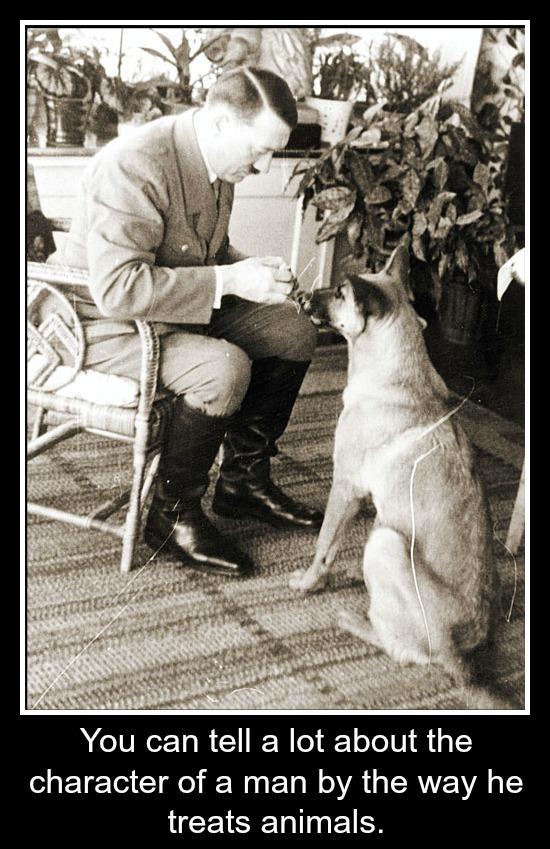Unknown Facts: The National Socialists decreed any form of animal cruelty a crime of the greatest magnitude and punished it accordingly. According to Goebbe’s diary entry of 26th April 1942 Hitler planned to gradually abolish slaughterhouses all over Europe after the successful completion of the war.
~ Animal Welfare in “Nazi Germany”
There was widespread support for animal welfare in “Nazi Germany” and the National Socialists took several measures to ensure the protection of animals. Many National Socialist leaders, including Adolf Hitler and Hermann Göring, were supporters of animal protection and environmentalists. Species protection and animal welfare were significant issues in the Hitlerite regime. The current animal welfare laws in Germany are modified versions of the laws introduced by the National Socialists.
At the end of the nineteenth century, kosher butchering and animal experimentation were the main concerns regarding animal protection in Germany. These concerns continued among the National Socialists. According to Boria Sax, the National Socialists rejected anthropocentric reasons for animal protection—animals were not to be protected for human interests—but for themselves. In 1927, a National Socialist representative to the Reichstag called for actions against cruelty to animals and kosher butchering.
In 1932, the National Socialist party proposed a ban on vivisection (animal experiments). In early 1933, representatives of the National Socialist party to the Prussian parliament held a meeting to enact this ban. On April 21, 1933, almost immediately after the National Socialists came to power, the parliament began to pass laws for the regulation of animal slaughter. On April 21, a law was passed concerning the slaughter of animals. On April 24, Order of the Prussian Ministry of the Interior was enacted regarding the slaughter of poikilotherms. Germany was the first nation to ban animal experiments. A law imposing a total ban on animal experiments was enacted on August 16, 1933, by Hermann Göring as the prime minister of Prussia. He announced an end to the “unbearable torture and suffering in animal experiments” and said that those who “still think they can continue to treat animals as inanimate property” will be sent to concentration camps. On August 28, 1933, Göring announced in a radio broadcast:
“An absolute and permanent ban on vivisection is not only a necessary law to protect animals and to show sympathy with their pain, but it is also a law for humanity itself…. I have therefore announced the immediate prohibition of vivisection and have made the practice a punishable offense in Prussia. Until such time as punishment is pronounced the culprit shall be lodged in a concentration camp.”
Göring also banned commercial animal trapping, imposed severe restrictions on hunting, and regulated the shoeing of horses. He imposed regulations even on the boiling of lobsters and crabs.
In 24 November 1933, “Nazi Germany” enacted another law called Reichstierschutzgesetz (Reich Animal Protection Act), for protection of animals. This law listed many prohibitions against the use of animals, including their use for filmmaking and other public events causing pain or damage to health, feeding fowls forcefully and tearing out the thighs of living frogs. The two principals (Ministerialräte) of the German Ministry of the Interior, Clemens Giese and Waldemar Kahler, who were responsible for drafting the legislative text, wrote in their juridical comment from 1939, that by the law the animal was to be “protected for itself” (“um seiner selbst willen geschützt”), and made “an object of protection going far beyond the hitherto existing law” (“Objekt eines weit über die bisherigen Bestimmungen hinausgehenden Schutzes”).
On February 23, 1934, a decree was enacted by the Prussian Ministry of Commerce and Employment which introduced education on animal protection laws at primary, secondary and college levels. On 3 July 1934, a law Das Reichsjagdgesetz (The Reich Hunting Law) was enacted which limited hunting. On 1 July 1935, another law Reichsnaturschutzgesetz (Reich Nature Conservation Act) was passed to protect nature. According to an article published in Kaltio, one of the main Finnish cultural magazines, Nazi Germany was the first in the world to place the wolf under protection.
In 1934, Nazi Germany hosted an international conference on animal protection in Berlin. On March 27, 1936, an order on the slaughter of living fish and other poikilotherms was enacted. On March 18 the same year, an order was passed on afforestation and on protection of animals in the wild. On September 9, 1937, a decree was published by the Ministry of the Interior which specified guidelines for the transportation of animals. Then, in 1938, animal protection was accepted as a subject to be taught in public schools and universities in Germany.
 RSS Feed
RSS Feed















 March 12th, 2013
March 12th, 2013  FAKE NEWS for the Zionist agenda
FAKE NEWS for the Zionist agenda 
 Posted in
Posted in  Tags:
Tags: 













